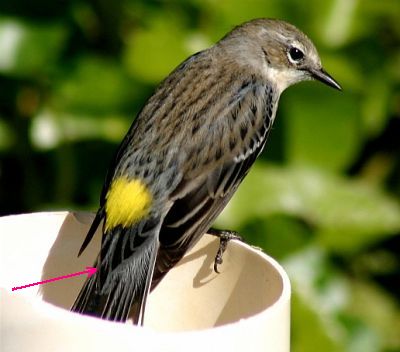 Here’s a bird who’s a natural for today’s anatomy lesson.
Here’s a bird who’s a natural for today’s anatomy lesson.
What’s that splash of bright yellow on this otherwise drab bird? It’s his rump and it gave him his name: yellow-rumped warbler.
Not only is this bird showing off his namesake but you can see a V of gray-edged dark feathers below his rump that overlap like shingles on a roof. These are his upper tail coverts, the feathers on the top side of his body that cover his tail. The pink arrow is pointing to them.
Upper tail coverts are usually bland feathers shorter than the tail, but peacocks have overturned that rule. Their fancy “tails” are actually very long upper tail coverts that they raise during courtship display. When they do this, they reveal a relatively small tail.
While our yellow-rumped warbler is paused, let’s use him to review some earlier anatomy lessons.
Can you see his nape? It’s plain and gray compared to his mantle which has long dark stripes on a brown background. If you look closely you can see the scapulars on his right wing, edged in brown. They’re draped over his primary upper wing coverts whose feathers are edged in white.
This yellow-rumped warbler is in basic (i.e. winter) plumage and is posed in a way that hides the field marks on his sides and head that indicate his sex. If he’s a male, he will molt his brown feathers and become black and white in the spring – but he’ll always keep his bright yellow rump.
What a cooperative bird! Chuck Tague photographed him in Florida where yellow-rumped warblers are very common in winter.
(photo by Chuck Tague)
Thanks for another “anatomy” lesson, Kate. I learn better visually such as viewing a real photograph like the one you have here and remember better than when I look at the guide books. The yellow-rumps are a very neat warbler, too, and I feel they are fairly “unafraid/shy” of humans as I’ve seen quite a few of them at Yellow Creek, Geneva Marsh in the woods, and Cris Hamilton photographed one at Crooked Creek when her, Bobby, and I were walking on the fitness trail. Easier to id in winter with that yellow rump!! (In spring/summer/fall they seem to have more blue and yellow on other wing parts, too.)
Yay for butter butts! I also really appreciate your lessons.
These lessons are great – and so much more helpful than the guidebooks. You should put together a guidebook of your own.
Quick question on these lovely birds! The actual yellow feathers—-are they just body feathers?
Yes, the rump feathers are body feathers called “upper tail coverts.”